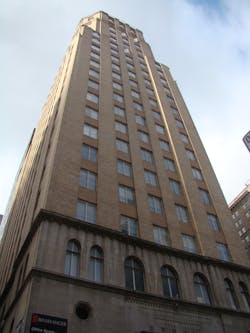Thermal-Energy Storage Helps Transform High-Rise Into Virtual Power Plant
Built in 1929, 1500 Walnut Street is a 22-story, 270,000-sq-ft commercial building in Philadelphia. When SSH Real Estate purchased the property in 2005, it was faced with a failing HVAC system.
“We had a number of tenants that wanted to leave,” building manager Gene O’Donnell said. “... The system we had in place was an energy hog that was affecting bottom-line revenue. ... There was no question we needed a new system.”
SSH Real Estate sought a system offering the best net present value and that would lower energy expenses, fit inside the building’s mechanical room, and not be difficult to operate. Also, it wanted the retrofit performed without building operations being interrupted and tenants affected.
Solution
In 2007, SSH Real Estate solicited bids to replace the building’s outdated 500- and 600-ton chillers and retained Tozour Energy Systems to perform life-cycle-cost analysis. The solution included two 300-ton chillers, as well as IceBank thermal-energy-storage tanks from CALMAC Manufacturing Corp.
“The circular design with the tube sheets rolled gets a lot more burn out of each cubic foot of CALMAC’s energy-storage tanks, significantly reducing the cost and size of each tank,” Kevin Keenan, manager of energy-project development for Tozour Energy Systems, said.
Results
The CALMAC system was installed while the building was in operation without tenant satisfaction being impacted. The energy-storage tanks fit easily into the building’s mechanical room, where the chillers also were located. Operators were trained to optimize the system, alleviating concerns about the system being overly complicated.
Initially, ice was made at night, when power was relatively inexpensive, and used to cool the building the following day, when power was more expensive. Following deregulation of the electricity market, however, power prices became difficult to predict.
First, controls and the building-automation system were upgraded, which reduced annual energy use from 1.6 million kwh to 1.1 million kwh. Then, with VPower software from Viridity Energy, the CALMAC system was changed to a demand-response system.
The load-optimization process of the VPower software determines the duration and rate of energy-storage charging and discharging. Building operators can call on stored energy to substantially reduce the mechanical cooling load for demand response without impacting tenants, unlike alternative demand-response methods, such as changing the thermostat and shutting off lights during energy emergencies.
Revenue Generator
The VPower software enabled building operators to forecast power prices and utilize the HVAC system to generate revenue.
“Viridity Energy can forecast where prices ... will be for the next day on an hour-by-hour basis and provide a schedule ... through the building-automation system, which the ice system is tied into, to make ice or burn ice,” H.G. Chissell, vice president, Northeast region and strategic accounts, Viridity Energy, said. “When they are using ice, they are not using their chillers, and their load drops. We can then make sure that the grid operator knows that this load is dropping during these hours and they don’t have to go to a power plant. The grid operator diverts the income, or the money, to the building.”
Keenan added: “Power companies have said: ‘If we need 1 MW of power to satisfy the grid, we can go to a power plant and see how much that would cost. Alternatively, we can pay you, the building owner, the same thing we would have paid the power plant for that megawatt.’ So, you’re actually getting a revenue stream by freeing up more power for the power plant to use.”
With energy storage, the HVAC-system upgrade, and the software, nearly $40,000 a month in energy is being saved during warmer months. Further, through response to market-based pricing and demand-response programs, $10,000 of revenue is being generated per year.
“This is found money,” O’Donnell said. “We don’t need 1 sq ft of space in this building to make this money, and the tenants in this building see no change at all. We’re as happy as pigs in mud. The system works.”
The CALMAC system provided a payback of just two years.
Summary
The new chillers and thermal-energy-storage tanks not only offered the best net present value and significantly cut energy costs, they are helping the building prepare for future changes in energy. Since deregulation, 1500 Walnut Street has used software from Viridity Energy to become the first building in downtown Philadelphia to integrate with the smart grid and use its HVAC system to earn revenue.
For Design Solutions author guidelines, call Scott Arnold at 216-931-9980, or write to him at [email protected].

